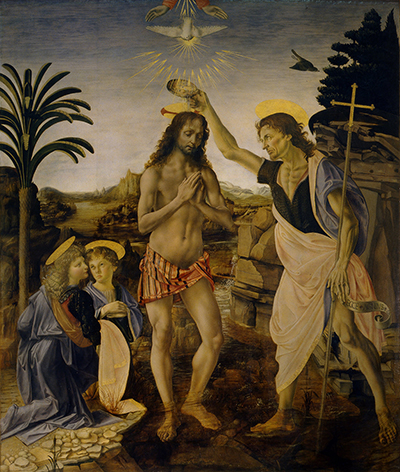The Baptism of Christ is a famous painting done by Andrea del Verrocchio, Leonardo da Vinci's master. Verrocchio completed the painting in 1472 with the help of da Vinci who finished some parts of the altarpiece.
The blonde angel on the left and landscape in the background was the part Leonardo da Vinci handled, and this work is famous due to his involvement. Notably, Baptism of Christ is different from other paintings which depict baptism as in this painting, Jesus Christ and St John the Baptist stand on the same plane. It is a unique piece of art completed during the Early Renaissance, highly influential because of the artists involved in its creation. This is the only painting that can be attributed with absolute certainty to Verrocchio.
In this work, Verrocchio expressed his preference for simplicity. He achieves this with refinement and great vigour but maintains a hard and angular style. This is one of the artworks done by Verrocchio using the technique of painting a picture. The technique was popular in Italy for durable items before it spread to Flemish and Dutch painters.
The plan is based on the Gospel of Mathew, Mark and Luke. The painting portrays St. John the Baptist at the time of Jesus's Christ baptism. Verrocchio was inspired by the Bible to create an artwork that resonates well in people's minds. He shows two angels on the left side of the altarpiece to complete four characters in the painting. Also, God's extended arms are shown with golden rays, accompanied by a dove whose wings are spread. On top of St. John the Baptist, and Jesus' head, is a halo with cruciform and the two angels hold the clothes of Jesus.
The monks of the San Salvi Church located near Florence commissioned the painting, where it remained until 1530. According to Antonio Billi (1515), it was transferred to Vallumbrosan Sisterhood located in Santa Verdiana. Subsequently, the collection of Accademia hand it over to Uffizi in 1959. At the moment, the painting is located at the Academy of Florence. Verrocchio did a large part of the painting using tempera on wood in collaboration with da Vinci who put final touches on some parts of the painting with a brush, particularly the part depicting the angel. Da Vinci used oil to paint the angel on the left side.
Verrocchio's artistic influence became evident through his sculptures, metal works and paintings. He ran the studio in Italy in conjunction with apprentices who become great artists. Aside from Leonardo da Vinci, the apprentices of Verrocchio include Lorenzo de Credi, Botticelli and Botticini. After painting the Baptism of Christ, his focus was on apprenticeship, exploring gifts in metal works and sculptures. Consequently, it was rumoured that Leonardo da Vinci had painted the angel so well that Verrocchio was ashamed of himself. He acknowledged that da Vinci understood colours so well because he was a superior painter.




